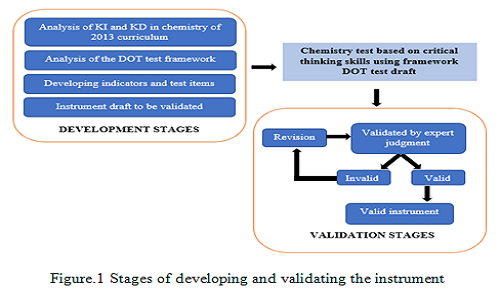
Development of Chemistry Tests for Students’ on Reaction Rate Subject Matter Based on Critical Thinking Skills using Framework DOT Test
Abstract
Keywords
Full Text:
PDFReferences
Adams, W.K & Wieman, C.E. (2010). Development and Validation of Instruments to Measure Learning of Expert-Like Thinking. International Journal of Science Education, 1(1), 1-24.
Amalia, N. F., & Susilaningsih, E. (2014). Pengembangan Instrumen Penilaian Keterampilan Berpikir Kritis Siswa SMA pada Materi Asam Basa. Jurnal Inovasi Pendidikan Kimia, Vol. 8, No. 2, pp. 1380-1389.
Anazifa, R. D., & Djukri, D. (2017). Project-Based Learning and Problem-Based Learning: Are They Effective to Improve Student’s Thinking Skills?. Jurnal Pendidikan IPA Indonesia, 6(2), 346-355.
Danczak, S. M., Thompson, C. D., & Overton, T. L. (2020). Development and validation of an instrument to measure undergraduate chemistry students’ critical thinking skills. Chemistry Education Research and Practice, 21(1), 62-78.
Kartini & Liliasari. (2012). Pengembangan Alat Ukur Berpikir Kritis pada Konsep Termokimia untuk Siswa SMA Peringkat Atas dan Menengah. Jurnal Pendidikan IPA Indonesia, Vol. 1, No. 2, pp. 21-26.
Kurniawan, R. A., & Fadhilah, R. (2018). Pengembangan Modul Pembelajaran Kimia berbasis Multipel Representasi pada Materi Laju Reaksi di SMA Panca Bhakti Pontianak. Pena Kreatif: Jurnal Pendidikan, 7(1), 1-12.
Liliasari. 1999. Pengembangan Model Pembelajaran Komputer Berdasarkan Konstruktivisme Untuk Meningkatkan Keterampilan Berpikir Tingkat Tinggi. Makalah dibacakan dalam Seminar Mutu Pendidikan dalam Rangka Dies Natalis 45 dan Lustrum IX IKIP Bandung, Pusat Studi Komputer Sains, IKIP Bandung.
Lutfianto, M., & Sari, A. F. (2017). Respon siswa terhadap soal matematika mirip PISA dengan konteks berintegrasi nilai islam. Jurnal Elemen, 3(2), 108–117.
Nurpratiwi, F. (2017) Pengembangan tes keterampilan berpikir kritis siswa sma kelas xi pada materi larutan penyangga. Skripsi S1, Universitas Pendidikan Indonesia.
Kemendikbud. (2018). Permendikbud No. 37 tentang kompetensi isi dan kompetensi dasar pelajaran pada kurikulum 2013 pendidikan dasar dan menengah. Kementerian Pendidikan dan Kebudayaan.
Khasanah, A. N., Widoretno, S., & Sajidan, S. (2017). Effectiveness of Critical Thinking Indicator Based Module in Empowering Student’s Learning Outcome in Respiratory System Study Material. Jurnal Pendidikan IPA Indonesia, 6(1), 187-195.
Sadhu, S., & Laksono, E. W. (2018). Development and Validation of an Integrated Assessment for Measuring Critical Thinking and Chemical Literacy in Chemical Equilibrium. International Journal of Instruction, 11(3), 557-572.
S. Suwandi. (2011). Model-Model Penilaian dalam Pembelajaran. Surakarta: Yuma Pustaka.
Wartono, W., Hudha, M. N., & Batlolona, J. R. (2018). How Are The Physics Critical Thinking Skills of The Students Taught by Using Inquiry Discovery Through Empirical and Theorethical Overview?. Eurasia Journal of Mathematics, Science and Technology Education, 14(2), 691-697.
Wilson, F. R., Pan, W. dan Schumsky, D. A. (2012). Recalculation of the Critical Values for Lawshe’s Content Validity Ratio. Measurement and Evaluation in Counseling and Development 45 (3), hlm. 197-21
DOI: http://dx.doi.org/10.31258/jes.5.4.p.702-711
Refbacks
- There are currently no refbacks.
Copyright (c) 2021 Rahmawati Nurfatihah

This work is licensed under a Creative Commons Attribution 4.0 International License.
Publisher: FKIP Universitas Riau













